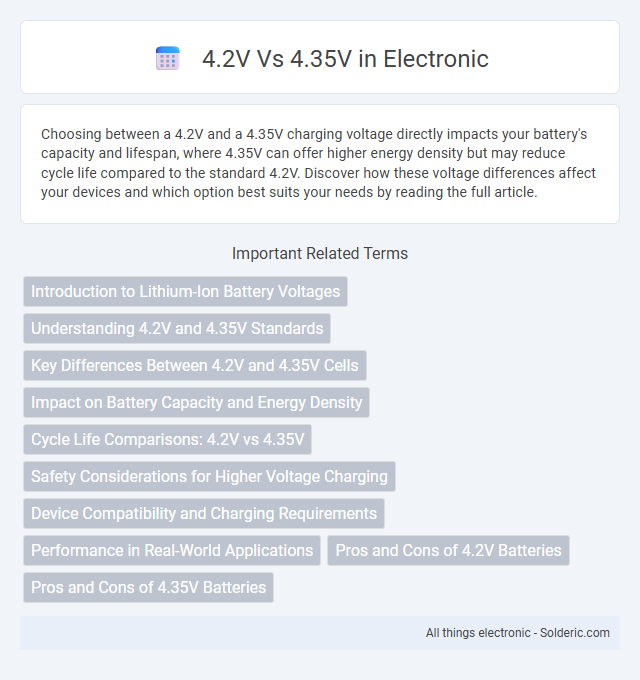Choosing between a 4.2V and a 4.35V charging voltage directly impacts your battery's capacity and lifespan, where 4.35V can offer higher energy density but may reduce cycle life compared to the standard 4.2V. Discover how these voltage differences affect your devices and which option best suits your needs by reading the full article.
Comparison Table
| Feature | 4.2V Battery | 4.35V Battery |
|---|---|---|
| Voltage | 4.2 Volts (Max Charge Voltage) | 4.35 Volts (Max Charge Voltage) |
| Capacity | Standard capacity, lower energy density | Higher capacity, up to 10% more energy |
| Chemistry | Typical Lithium-ion (Li-ion) | Enhanced Lithium-ion with higher voltage tolerant cathodes |
| Cycle Life | Longer cycle life (~500-1000 cycles) | Shorter cycle life due to higher voltage stress (~300-700 cycles) |
| Safety | More stable, lower risk of overheating | Higher risk; requires better battery management systems |
| Use Cases | Consumer electronics, standard electric vehicles | High-performance devices needing more energy density |
| Charging Requirements | Standard Li-ion chargers | Specialized chargers supporting higher voltage |
Introduction to Lithium-Ion Battery Voltages
Lithium-ion batteries commonly operate at nominal voltages around 3.6V to 3.7V per cell, with maximum charge voltages typically set between 4.2V and 4.35V. The standard 4.2V cutoff voltage balances energy density and battery lifespan, while 4.35V offers higher capacity but increases stress on the cathode materials, potentially reducing cycle life. Manufacturers select voltage limits based on application requirements, balancing energy output and safety considerations for optimal performance.
Understanding 4.2V and 4.35V Standards
The 4.2V and 4.35V standards refer to the maximum charging voltages for lithium-ion batteries, with 4.35V batteries offering higher energy density and slightly longer runtime compared to 4.2V counterparts. Charging to 4.35V involves precise battery management systems to ensure safety and longevity, as the increased voltage can stress the battery if not properly controlled. Understanding the differences helps you optimize battery performance while maintaining safe charging practices.
Key Differences Between 4.2V and 4.35V Cells
4.2V cells typically use lithium cobalt oxide (LiCoO2) chemistry, offering proven safety and compatibility with most devices, while 4.35V cells usually employ high-voltage cathodes like lithium nickel manganese cobalt oxide (NMC) for increased energy density and longer runtime. Charging 4.35V cells requires precise voltage management to prevent overcharging, enhancing performance but demanding compatible chargers and battery management systems. Your choice between 4.2V and 4.35V cells impacts device battery life, charge cycles, and thermal stability, making it crucial to match cell voltage to the intended application.
Impact on Battery Capacity and Energy Density
Charging a lithium-ion battery to 4.35V instead of the standard 4.2V increases the battery capacity and energy density by allowing more lithium ions to be stored in the cathode material, resulting in longer usage times for your device. However, this higher voltage also subjects the battery to increased stress and faster chemical degradation, potentially reducing the overall cycle life and safety. Balancing the trade-off between maximum charge voltage and battery longevity is essential for optimizing performance and reliability.
Cycle Life Comparisons: 4.2V vs 4.35V
Charging lithium-ion batteries to 4.35V increases energy density but typically reduces cycle life compared to 4.2V charging, with 4.2V cells often achieving over 500 full charge-discharge cycles while 4.35V cells may see a decrease to around 300-400 cycles. The higher voltage accelerates electrolyte degradation and electrode wear, which compromises long-term battery stability and capacity retention. Manufacturers balance the trade-off between extended runtime and shortened cycle life when selecting charging voltages for consumer electronics and electric vehicles.
Safety Considerations for Higher Voltage Charging
Charging lithium-ion batteries at 4.35V offers increased capacity but raises significant safety concerns due to higher voltage stress, which can accelerate electrolyte degradation and increase the risk of thermal runaway. Manufacturers often implement strict battery management systems (BMS) and safer electrode materials to mitigate these risks when using 4.35V charging profiles. Your battery's longevity and safety depend on using a charger and battery chemistry specifically designed for higher voltage operation to prevent overheating and potential hazards.
Device Compatibility and Charging Requirements
Choosing between 4.2V and 4.35V charging voltages significantly impacts device compatibility and charging requirements. Most consumer electronics are designed for a 4.2V charge limit to ensure battery safety, while some newer devices support 4.35V for extended battery capacity and longer runtime. Your charger and device firmware must align with the specific voltage to prevent battery damage and ensure optimal performance.
Performance in Real-World Applications
Charging lithium-ion batteries to 4.35V instead of 4.2V increases energy density, providing longer runtime in smartphones, laptops, and electric vehicles. However, operating at 4.35V can accelerate battery degradation and reduce overall cycle life compared to the more stable 4.2V limit. Your choice between these voltages depends on whether maximizing immediate device performance or ensuring prolonged battery longevity is more critical.
Pros and Cons of 4.2V Batteries
4.2V batteries offer a balance between energy density and safety, providing reliable performance with lower risk of overheating or capacity degradation compared to higher voltage options. They tend to have longer cycle life and stability, making them ideal for everyday consumer electronics and less demanding applications. However, these batteries deliver slightly less capacity and runtime than 4.35V batteries, which can limit their use in high-power devices requiring maximum energy storage.
Pros and Cons of 4.35V Batteries
4.35V batteries offer higher voltage capacity, resulting in increased energy density and longer runtime compared to standard 4.2V batteries, making them ideal for high-performance electronics. However, the increased voltage can accelerate battery degradation and reduce overall lifespan if not managed with advanced battery management systems. These batteries also require compatible chargers and careful thermal management to ensure safety and optimal performance.
4.2V vs 4.35V Infographic

 solderic.com
solderic.com